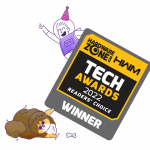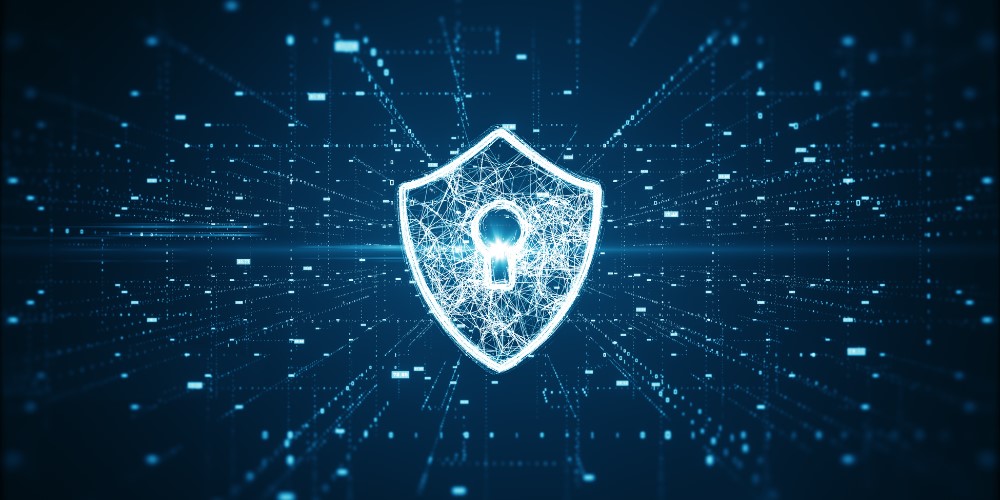Discovering the Value of IoT Solutions
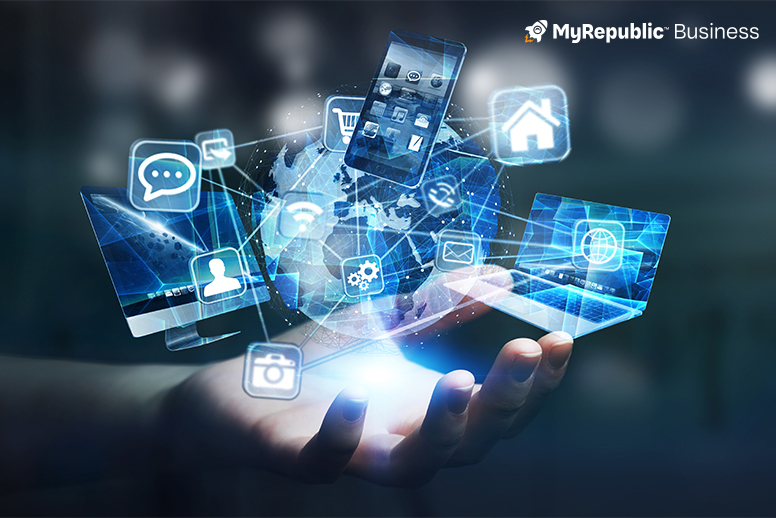
The Internet of Things (IoT) is a network that links physical devices embedded with sensors, software, and diverse technologies to collect and exchange data over the internet. It has reshaped our lifestyles and industries. The interconnection of everyday objects, such as kitchen appliances, cars, and thermostats, opens up a new era of convenience and efficiency across sectors. Within the IoT ecosystem, data is collected across a diverse array of objects and devices. This data then undergoes analysis and processing to initiate actions, offer insights, or automate processes. IT solutions providers play a crucial role in implementing and optimising IoT solutions to boost connectivity and functionality in various industries.
Thanks to the combination of low-cost computing, cloud infrastructure, big data, analytics, and mobile technologies, physical objects can share and collect data with minimal human intervention. Digital systems are then able to record, monitor, and adjust interactions between connected things, bridging the gap between the physical and digital realms. In this article, we delve into the profound impact of IoT solutions, exploring how they have revolutionised modern processes and lifestyles.
IoT SOLUTIONS IN OUR MODERN DAY
2.1 Components of IoT Solutions
The successful deployment of IoT solutions depends on the synergy of several key components. They serve as building blocks that support the establishment of intelligent and connected ecosystems, fostering efficiency and innovation in our interconnected world.
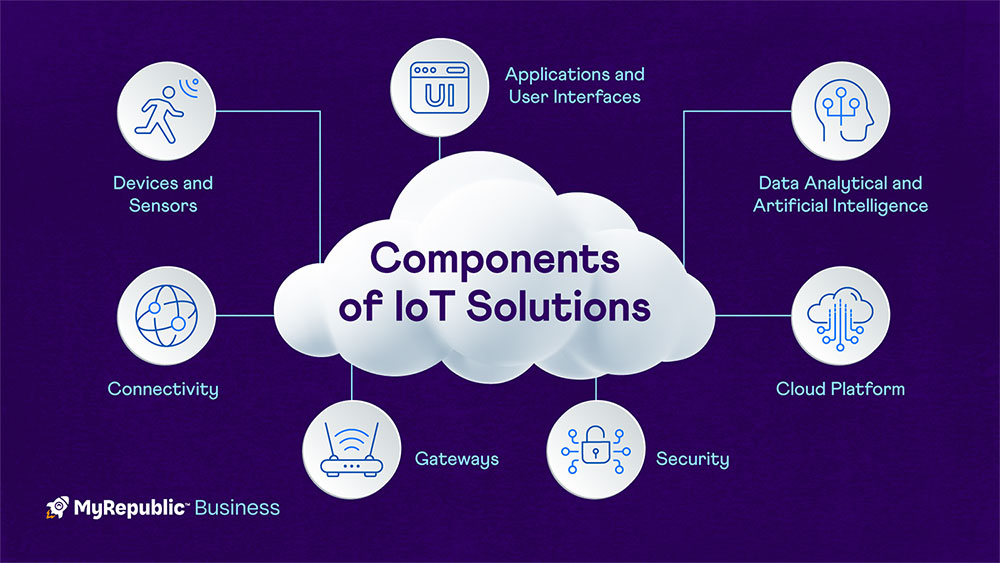
1. Devices and Sensors
Within the IoT solution, devices and sensors work together to initiate data flow, which is essential for informed decision-making. Each of these components is designed with a particular task or function in mind to capture and record relevant data points. For example, humidity sensors concentrate on monitoring environmental conditions, while accelerometers are used to identify changes in acceleration or movement. This purposeful design ensures that each device and sensor contributes to the overall data collection process.
2. Connectivity
Connectivity must be present to facilitate real-time information transfer and collaborative interactions within the expansive IoT network. Communication protocols such as Wi-Fi, Bluetooth, cellular networks, and commercial broadband complement the system for smooth data exchange.
3. Gateways
Gateways in IoT are specialised devices that connect edge devices or sensors to unified cloud service platforms or central data processing systems. They can condense the data volume to minimise the amount of bandwidth required for transmission, shortening data transfer times and reducing latency.
4. Cloud Platform
A cloud platform resembles the central hub in IoT systems, where data from various devices is stored, processed, and analysed. It can also support advanced analytics, artificial intelligence (AI), and machine learning applications. Integrating connectivity options like corporate internet can improve the capabilities of these cloud-based IoT solutions.
5. Data Analytics and Artificial Intelligence (AI)
An effective IoT ecosystem comprises data analytics and AI, which jointly convert raw data into actionable insights. They help organisations to better analyse patterns and trends for informed decision-making, outcome prediction, and process automation.
6. Security
Given the sensitive nature of data transmitted in IoT ecosystems, robust cybersecurity solutions are paramount. This includes encryption, authentication, and authorisation protocols to safeguard data integrity and protect against unauthorised access. Such security measures ensure the reliability and trustworthiness of the entire IoT infrastructure.
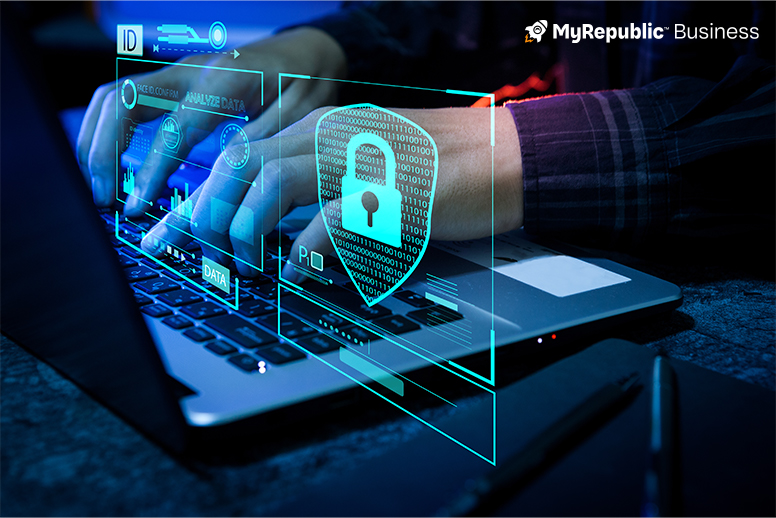
7. Applications and User Interfaces
Applications and user interfaces facilitate user interaction and device connectivity within the IoT ecosystem. The versatile IoT applications enable users to manipulate data generated by their connected devices, while user interfaces deliver an intuitive experience for effortless management of the interconnected devices.
2.2 The Role of IoT Solutions in a Connected World
IoT solutions encompass multiple smart devices and systems to transfer data without requiring human-to-human or human-to-computer interactions. In this section, we discover how these solutions bolster the capabilities of today’s digital era.
1. Enhanced Efficiency and Automation
IoT solutions improve workflow efficiency by streamlining organisational processes. The platforms often offer configurable settings for organisations to adjust parameters, data collection points, and automation rules. For example, companies can configure higher data collection frequencies during working hours for real-time occupancy monitoring and environmental control. In addition, IoT solutions automate routine tasks through connected devices to realise efficient, error-free task execution. It is worth mentioning that incorporating the internet for business connectivity amplifies the capabilities of these solutions, enhancing various aspects of organisational processes.
2. Real-Time Data Insights
IoT devices leverage connectivity protocols such as business or event Wi-Fi, Bluetooth, Zigbee, or cellular networks to collect real-time data through embedded sensors. The data is then aggregated at a physical server or a cloud-based IoT platform for sharing across the organisation. This piece of information provides valuable insights for businesses to assess their operations, analyse customer behaviour, and monitor overall performance.
3. Improved Safety and Security
Empowered by IoT solutions, both individuals and organisations can establish safer environments through real-time monitoring, proactive alert systems, and predictive maintenance features. Imagine if a fire were to break out in a smart building. The equipped IoT sensors that are constantly monitoring environmental conditions such as smoke, temperature, and air quality in real-time will trigger a proactive alert system to notify occupants and emergency services if they sense a potential fire hazard. A similar concept is deployable in smart homes – residences featuring interconnected technologies that automate daily life. IoT solutions elevate home security levels by providing homeowners with real-time alerts and remote monitoring capabilities.
4. Optimised Resource Management
While IoT-enabled devices are pivotal in ensuring efficient resource management for businesses, a robust internet business plan is key to an uninterrupted optimisation process. Not only will companies be able to monitor and control resource consumption, IoT solutions can also be linked up seamlessly to improve operations.
5. Enhanced Personalisation and User Experiences
IoT solutions aid the data-gathering process about user preferences, behaviour, and context. They deploy interconnected devices and sensors to capture a wide range of data, which then undergoes machine learning algorithms and other advanced analytics. After thorough analysis, this data becomes insights for businesses to customise their offerings for improved customer experience.
2.3. Business Fields That Can Benefit From IoT Solutions
From streamlining manufacturing processes to improving healthcare delivery, IoT is leaving a substantial impact on various industries. Let’s take a look at how various business fields are harnessing this innovative technology to drive efficiency.
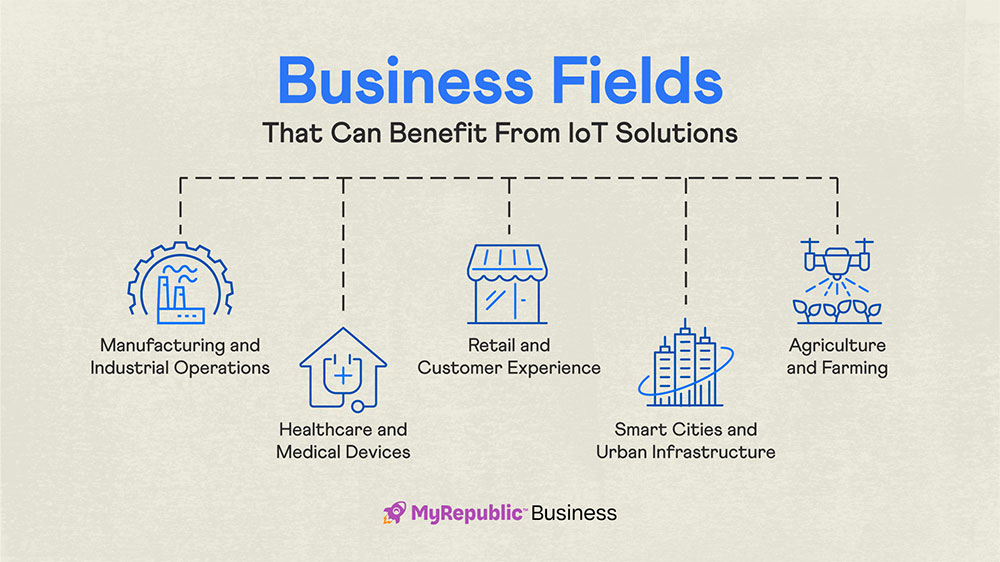
1. Manufacturing and Industrial Operations
IoT-enabled sensors and devices are integrated into machinery and production lines to monitor real-time performance, track inventory levels, and predict maintenance needs. These sensors and devices are used to capture and transmit real-time data, which cover the performance metrics of machines, the status of production lines, and the overall health of equipment. Thanks to these insights, manufacturers can quickly assess the efficiency and productivity of each equipment in the production area. This enables the prompt identification of any issues or deviations from optimal performance.
2. Healthcare and Medical Devices
In the healthcare sector, IoT solutions assist in the development of connected medical devices – wearable health trackers, remote monitoring equipment, and more, to facilitate continuous health monitoring. They also ease hospital operations by automating processes of asset tracking, inventory management, and patient flow monitoring. In these cases, the presence of internet solutions, like business broadband in Singapore, becomes integral in ensuring seamless connectivity.
3. Retail and Customer Experience
More retailers are adopting in-store IoT solutions to enhance operational efficiency. Automated checkout processes, smart shelves, intelligent inventory management, and other technologies are becoming essential to enhance the overall shopping experience. These smart tools save precious time for retailers, empowering them to focus on developing more targeted marketing strategies.
4. Smart Cities and Urban Infrastructure
Next, IoT contributes to intelligent urban infrastructure setup, paving the way for the development of smart cities. Interconnected devices and sensors actively monitor key aspects such as traffic flow, energy consumption, waste management, and public safety. They generate valuable data for authorities to optimise city services, minimise environmental impact, and improve urban living quality.
5. Agriculture and Farming
IoT applications in the agriculture industry enables farmers to optimise irrigation schedules, take targeted pest control measures, and adjust farming practices based on accurate environmental data. Apart from smart sensors and drones, automated irrigation systems, GPS-guided tractors, and livestock monitoring devices play a significant role in resource optimisation and yield improvement processes. Such an integration promotes environmentally conscious agricultural practices as a whole.

DIVING INTO THE WORLD OF TELECOMMUNICATIONS
3.1. Deployment of Business Internet for Professional Services
In this section, we delve into the benefits of deploying business internet for professional services, exploring how it enhances connectivity to elevate standards of service delivery within the professional services industry.
1. Efficient Communication
The reliability of business internet develops consistent and uninterrupted communication channels for professional services. With high-speed connectivity, professionals can engage in seamless video conferencing, voice calls, and real-time messaging, allowing organisations to work beyond geographical constraints.

2. Seamless Data Sharing
Whether it’s large files, important documents, or major project blueprints, high-speed internet for businesses allows professionals to exchange data securely and promptly. Even the largest and most sensitive documents can be transmitted with faster upload and download speeds.
3. Collaboration on Projects
Through cloud solutions, cloud-based platforms, and other collaborative tools, professionals can rely on the business internet to jointly work on projects in real time, regardless of their physical location. They may find it easier to contribute their expertise, leading to enhanced service delivery and client satisfaction.
3.2 Getting to know VoIP service
Instead of using traditional telephone lines, Voice Over Internet Protocol (VoIP) services convert voice signals into digital data packets that can be transmitted over the internet. Here are their key roles:
1. Rich Communication Features
VoIP services offer rich features beyond traditional voice calls – video conferencing, instant messaging, file sharing, and collaborative tools, to improve connectivity and collaboration within business environments. As these services are scalable, organisations can accommodate the growth of teams or other organisational changes without compromising on communication efficiency.

2. Integration with Business Tools and Applications
Streamlined communication workflows are no longer wishful thinking with the deployment of VoIP services. Seamlessly integrating these services with business tools and applications, such as customer relationship management (CRM) systems and project management platforms, creates a smooth workflow where communication is closely tied to broader business processes.
3. Business Continuity and Disaster Recovery
Unforeseen events or disasters can be detrimental to business operations. Fortunately, VoIP services allow businesses to swiftly redirect calls to alternative locations or devices during contingencies, searching for recovery strategies when necessary.
4. What Constitutes VoIP Services?
First of all, there are VoIP gateways that act as intermediaries to convert analog signals to digital data, connecting traditional telephone networks to internet-based VoIP systems. Concurrently, VoIP servers handle call routing, signalling, and user registration, directing calls across the network with precision. When it comes to initiating, modifying, and terminating communication sessions, the standardised Session Initiation Protocol (SIP) is vital for managing multimedia communication and supporting additional features. VoIP services also comprise Codecs (Coder-Decoders), which encode and decode audio signals. They compress data for efficient transmission while maintaining voice quality. Furthermore, VoIP protocols define the rules for signalling to ensure interoperability among diverse VoIP systems.
3.3 Attack Surface Management
Attack Surface Management (ASM) is crucial in cybersecurity because it covers the overall management of weak points prone to cyber threats. The key components of ASM include Discovery, Assessment, Prioritisation, and Remediation.
The discovery phase involves the identification and categorisation of potential entry points, vulnerabilities, and assets (all in terms of digitalisation) within an organisation. During the assessment stage, professionals evaluate the susceptibility of the aforementioned elements to potential attacks. Next, prioritisation assigns levels of importance or risk to each identified vulnerability so that resources are allocated efficiently for mitigation efforts. Finally, remediation focuses on the proactive steps taken to address and resolve the vulnerabilities. Together, these components form a robust framework for organisations to systematically manage their attack surfaces in response to potential cyber threats.

3.4 Questions You May Have
1. What are some common cybersecurity threats?
Common cybersecurity threats include malware (such as viruses, worms, and ransomware), phishing attacks, hacking, social engineering, denial-of-service (DoS) attacks, and data breaches. These threats can lead to data loss, financial loss, reputational damage, and other negative consequences.
2. What is business broadband and why is it important for businesses?
Business broadband refers to high-speed internet connectivity designed specifically for business use. It is important for businesses because it provides faster and more reliable internet access, which is crucial for efficient communication, online transactions, data transfers, cloud-based applications like Cloud pbx, video conferencing, and other essential business activities.
3. What measures should businesses take to enhance cybersecurity?
Businesses should implement a multi-layered approach to cybersecurity, which includes measures like regularly updating and patching software and systems, conducting regular security assessments and audits, educating employees on cybersecurity best practices, implementing firewalls and intrusion detection systems, encrypting sensitive data, and having an incident response plan in place to mitigate and respond to potential cyber incidents.
CONCLUSION
The importance of Internet of Things (IoT) solutions in today’s interconnected world cannot be overstated. By tapping into the capabilities of IoT, businesses open doors to novel opportunities, streamlined operations, and improved decision-making processes. Furthermore, the ability to gather, analyse, and leverage real-time data from interconnected devices empowers organisations with valuable insights in optimising processes for a more personalised customer experience. As the IoT ecosystem evolves, businesses must stay abreast of technological advancements to harness the full potential of IoT solutions.
MyRepublic strives to create a connected world characterised by intelligence, seamless experiences, and paramount safety. Stay connected with our services today!










